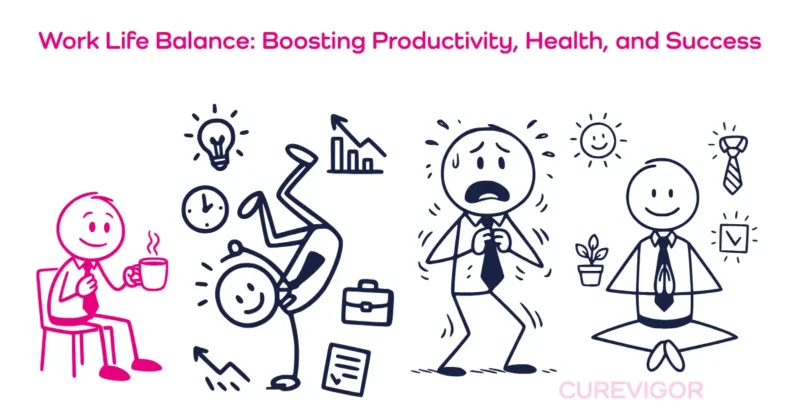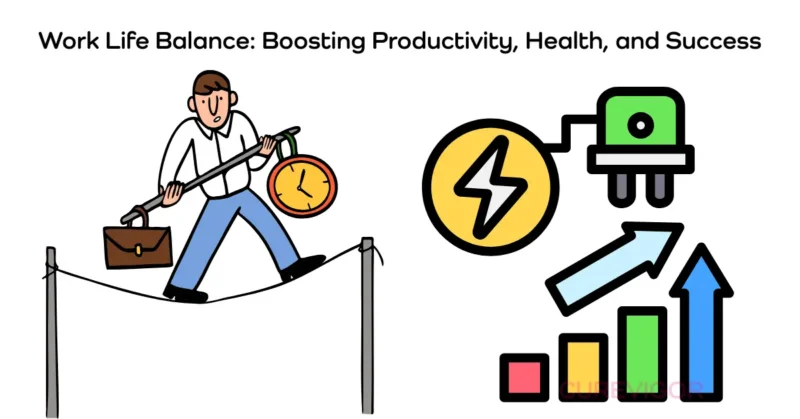Stop the burnout cycle! Find out the importance of work life balance for boosting productivity, improving mental health, and achieving sustainable career success. Get actionable strategies now.
Thank you for reading this post, don't forget to subscribe!In today’s hyper-connected world, the line between professional life and personal time has never been blurrier.
With emails and instant messages available 24/7, the pressure to always be “on” is immense.

But sacrificing personal time for the sake of career advancement is not only unsustainable—it’s detrimental to your long-term professional success.
The concept of work life balance isn’t about splitting your time exactly 50/50. It’s about achieving a state of harmony where you feel fulfilled and content in both your career and your personal life.
Prioritizing this balance is now a non-negotiable strategy for achieving true success, boosting employee well-being, and unlocking maximum productivity.
The Critical Connection: Work Life Balance and Mental Health
Ignoring your need for rest and personal time has profound consequences, primarily impacting your mental health and physical well-being. Chronic stress from overworking is a direct precursor to severe conditions.

The Dangers of Burnout and Stress
A sustained poor balance is the fast track to burnout, a state of emotional, physical, and mental exhaustion.
Research consistently links long working hours and high-stress environments to increased risks of anxiety, depression, and even physical ailments like heart disease.
When you encourage or practice a balanced life, you actively reduce burnout, allowing the mind to recharge and build resilience.
This translates directly to a healthier, more focused, and emotionally regulated individual.
Work Smarter, Not Harder: The Productivity Boost
Contrary to the belief that more hours lead to greater output, studies repeatedly show that well-rested employees are significantly more effective.
Work life balance is arguably the single most effective tool for sustainable productivity growth.
- Improved Focus and Cognitive Clarity: When you take proper breaks and disconnect at the end of the day, your brain has time to process and rest.
This renewed cognitive clarity allows you to approach tasks with greater focus, creativity, and problem-solving ability. - Higher Quality of Work: An employee who isn’t constantly distracted by fatigue or stress produces higher quality, more innovative work. They are present in the moment and dedicated to the task at hand.
- Reduced Absenteeism: Supporting employees and allowing them to take care of themselves and attend medical appointments reduces stress-related illnesses and absenteeism.
The Organizational Advantage: Retention and Culture
For businesses, championing a balanced approach is no longer a perk—it’s a foundational strategy for talent management, directly affecting employee retention and the bottom line.
| Organizational Benefit | Impact on the Business |
| Higher Retention Rates | Companies that prioritize employee well-being become magnets for top talent. A positive culture is the ultimate recruiting tool. |
| Stronger Employer Brand | Companies known for prioritizing employee well-being become magnets for top talent. A positive culture is the ultimate recruiting tool. |
| Increased Engagement | When employees are happy and feel valued, their employee engagement and morale skyrocket. This leads to employees who are willing to go the extra mile. |
Actionable Strategies for Achieving Balance
Achieving equilibrium is a personal journey, but you can implement proven strategies today to reclaim your time and energy.

Set Firm Boundaries
This is the most crucial step. Decide on clear, non-negotiable limits for your work.
- Designate “Off” Hours: Commit to powering down work devices and checking email only during specified work times.
If you work from home, create a physical separation (a dedicated workspace) and “commute” by taking a walk around the block to signal the end of the workday. - Use Your PTO: Vacation time is not a luxury; it’s a necessity for mental restoration. Encourage and mandate the use of paid time off (PTO) and ensure you truly unplug when away.
Master Time Management and Prioritization
Use techniques that maximize efficiency during work hours, reducing the need to work longer.
- Time Blocking: Allocate specific, dedicated blocks of time for similar tasks (e.g., an hour for email, two hours for deep work, a block for meetings).
- The Power of No: Learn to decline commitments politely—both professional and personal—that do not align with your core priorities or add value. Guard your time fiercely.
Prioritize Self-Care and Movement
Your physical and mental health must be scheduled just as you would an important meeting.
- Movement is Non-Negotiable: Schedule physical activity (a walk, a workout, yoga) into your day. Even short breaks to stretch or walk away from your desk can dramatically reduce stress and refresh your focus.
- Sleep and Nutrition: Ensure you get 7–9 hours of quality sleep and fuel your body with nutritious food. These habits are the foundation upon which your energy and resilience are built.
Don’t let burnout define your professional life. Which of these essential work life balance strategies—like time blocking or setting firm boundaries—will you implement first?
Share your loving tip in the comments below, or subscribe to our newsletter for more evidence-based well-being and productivity guides!
Frequently Asked Questions
Q. What is the true definition of work life balance?
Work-life balance isn’t about dividing your time equally (like 50% work, 50% life). Instead, it’s a deeply personal state of harmony in which you feel fulfilled and content in both your professional and personal life.
It means having enough energy and time for your job, family, hobbies, and self-care without one area consistently overwhelming the others.
It’s about sustainable engagement, reducing stress, and building mental resilience so you can perform at your best, regardless of where you are focusing your time.
Q. How does poor work life balance lead to burnout?
Poor balance creates chronic, unrelieved stress, leaving the mind and body constantly in a state of high alert.
When you consistently work long hours and neglect essential rest, self-care, and personal relationships, your physical and emotional resources become severely depleted.
This prolonged exhaustion leads to burnout, which is characterized by feelings of cynicism, reduced professional efficacy, and deep emotional drain.
The inability to fully disconnect means you never truly recover, making burnout an inevitable consequence of an imbalanced schedule.
Q. Can a better work life balance actually increase productivity?
Absolutely. The notion that working longer hours equals more productivity is a long-standing myth. When employees prioritize balance and get adequate rest, their cognitive function improves dramatically.
This leads to increased focus, sharper critical thinking, and enhanced creativity during work hours.
Rested individuals make fewer mistakes and approach tasks with renewed energy and enthusiasm, resulting in higher-quality output in less time.
It’s truly about maximizing efficiency and working smarter, not simply increasing the quantity of hours worked.
Q. What is the most effective way to set boundaries between work and home?
The most effective boundary involves a multi-pronged approach, starting with strict digital detachment.
Commit to powering down all work-related devices and silencing notifications outside of your scheduled work hours.
If you work remotely, create a physical boundary by using a dedicated workspace and having a “ritual” to mark the end of your workday, like taking a short walk.
Crucially, communicate these boundaries clearly and respectfully to your colleagues and management so they understand when you are genuinely unavailable and can plan accordingly.
Q. How does work life balance affect employee retention for businesses?
Nowadays, one of the main factors influencing employee retention is work life balance.
Workers report far higher job satisfaction and stronger loyalty to their companies when they feel supported in juggling their personal and professional obligations.
On the other hand, businesses with unsatisfactory work life policies experience much higher employee turnover, which is extremely expensive due to the costs of hiring, onboarding, and training new employees.
Setting balance as a top priority shows that a business values its employees, a significant advantage for attracting and retaining talent.
Q. Is work life balance different when working remotely?
Yes, remote work significantly changes the balance dynamics because work and life spaces physically merge.
While remote work offers increased flexibility, it requires much stricter discipline and boundary setting to maintain separation.
The sheer convenience of working from home can easily lead to work constantly bleeding into personal time, making it harder to mentally “switch off.”
You must intentionally create separation—by using a dedicated work area and strictly adhering to set start and end times—to avoid the common trap of constant availability.
Conclusion: The Path to Sustainable Success—The T.E.M.P.E.R. Framework
Striking a work-life balance is a sign of maturity and strategic thinking, not weakness.
It is the key component that keeps employees from burning out, increases output, and strengthens retention.
Finally, achieving this long-term success necessitates a comprehensive strategy that addresses all aspects of your life.
The T.E.M.P.E.R. (Time, Energy, Mind, Relationships, Environment, and Rest/Rewards) can be managed with the guidance of this guide.
By establishing limits and prioritizing your health in these six areas, you are laying the groundwork for long-term success on both a personal and professional level.
Begin making these adjustments right now, and you will see an increase in both your productivity and quality of life.
Read more articles on Health and Balance.
You might love:


